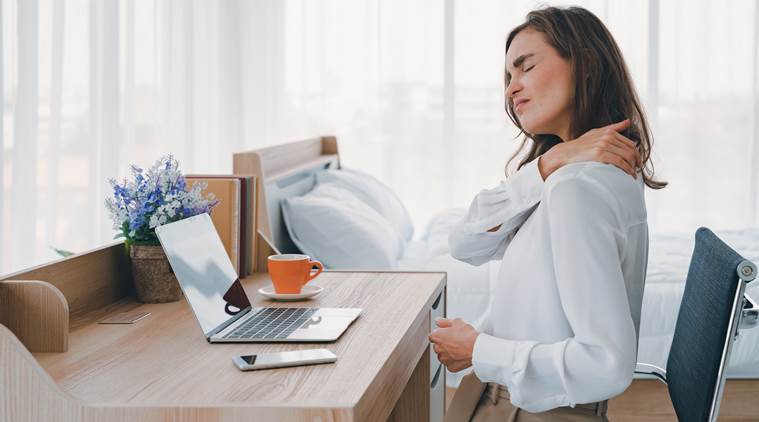Suffering from back pain? Here’s what doctors advise during work-from-home
For a lot many people, this change of routine has brought about its share of indiscipline. Now, they are all glued to their screens, typing away, not taking a moment to get up and stretch a bit.

How is the work-from-home experience going for you? While many people would have jumped at the prospect of getting to work from the comfort of their house, the exercise does not come without its own share of troubles. For starters, it has a reputation for making you feel incredibly lazy. While previously you would wake up, take a bath and dress up for work — not to forget the daily drudgery of commute hours — now you are just about waking up and logging in to your system, all bleary-eyed.
What’s worse is, for a lot many people, this change of routine has brought about its share of indiscipline. Now, they are all glued to their screens, typing away, not taking a moment to get up and stretch a bit, forget engaging in any kind of physical activity, or finding the time to hydrate themselves. You have been asked to stay at home, not stay in bed all day, every day.
ALSO READ | Esha Deol: Every woman should give an hour of fitness to herself every day
And if you have not started experiencing the danger of laziness yet, chances are you will feel it in the coming days; remember 21 days is a long time.
Indianexpress.com reached out to health experts to find out ways in which people are taking their body for granted — not exercising, not moving around inside the house — and what they can do to counter body ache, muscle pain and back pain, which are residue of lethargy.
“Back pain is a common thing to happen to people when they work from home. It can come and go, be constant, worsen with prolonged sitting, and/or be associated with neurological symptoms like numbness and tingling. Some of the common causes can be: sitting in a wrong posture, sitting for a prolonged period of time, or sitting without any support at the back,” Dr Yash Gulati, consultant orthopedic surgeon at Apollo Hospital, said.
According to Dr Gulati, people must always be mindful of a few things when they are sitting at home. “It is crucial that you vary your posture throughout the day, because sitting in the same position can lead to back, neck and shoulder pain. Placing a thin pillow underneath your seat can make an ordinary chair a lot more comfortable. Elevate your laptop so that your neck is not strained, and take a break after an hour or so, for three to five minutes,” he said.
To prevent the pain, Dr Akhilesh Yadav, senior joint specialist, Max Hospital (Vaishali and Patparganj) suggested that people engage in yoga, muscle strengthening and stretching exercises daily. “Moreover, there should be proper nutrition and water intake throughout the day. Since everyone is confined to their house, proper eating habits should be maintained. You cannot just eat whenever you feel like. Fruits, salads or some light food can be eaten, besides proper meals,” he said.
ALSO READ | Here’s how Shilpa Shetty is keeping her family fit during lockdown; watch video
And what about people who do not have a designated work space at home, like a chair or a table, and have to sit on the bed and work?
“There is no substitute for using a table and a chair. Ideally people should make necessary arrangements. In any case, getting up at regular intervals is important for maintaining good posture. Suryanamaskar is ideal for stretching, strengthening and flexibility. Most of us live in apartments where there is not much space to run and jog,” Dr Yadav said.

Dr Debashish Chanda, consultant orthopedics, CK Birla Hospital, Gurgaon, meanwhile, has suggested the following exercises for back pain relief:
* To relieve the muscle tension in the back, rock your pelvis back and forth, while seated in your desk chair, tilting your hips up and rounding your back, and then tilting your hips back.
* Quadruped arm and leg raise: Get down on your hands and knees. Pull in your belly button and tighten your abdominal muscles to stiffen your spine. While keeping your abdominals tight, raise one arm and the opposite leg away from you. Dip your left knee down toward the floor and bend your right leg.
* Seated glute stretch: Sit on the floor and extend your legs out in front of you. Keeping your back straight, lift your left leg and place your left ankle on your right knee. Lean slightly forward to deepen the stretch. Hold for 20 seconds then repeat on the opposite side.
ALSO READ | Want to burn calories sitting at home? Try doing these household chores
* Side plank: The side plank is a great exercise for strengthening the oblique abdominal muscles, which don’t get worked during ab exercises such as crunches. You will hold your body on your side in straight position supported only by one arm and the side of one foot.
* Cat and camel stretches: First arch your back up toward the ceiling, like an angry cat. Increase the movement with a deep inhale. Then exhale, tighten (or brace) your abdominals, drop your chest toward the floor and lift your head slightly. This exercise stretches the connective tissue around your nerve roots (nerve branches that come from the spinal cord).
Dr Chanda said that one must not resort to vigorous massage, because it “may aggravate the muscle spasm”. “As a pain reliever, make use of hot water bag for fermentation and apply pain relieving ointments and balms,” he said.
? The Indian Express is now on Telegram. Click here to join our channel (@indianexpress) and stay updated with the latest headlines
For all the latest Lifestyle News, download Indian Express App.
Source: Read Full Article





